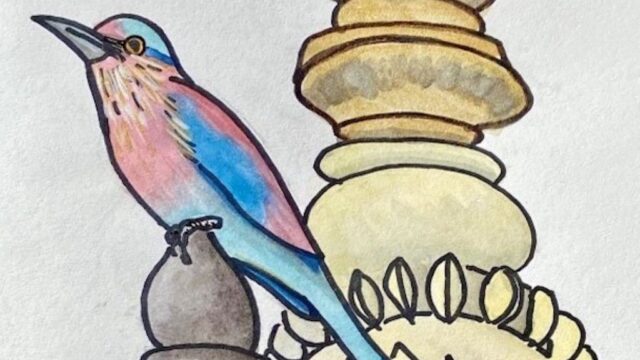
Blog 8. Reaching Nirvana via Erotic Temple Sculptures – Varanasi to Panna via Khajaraho
Day 6 Tuesday 19th November 2019
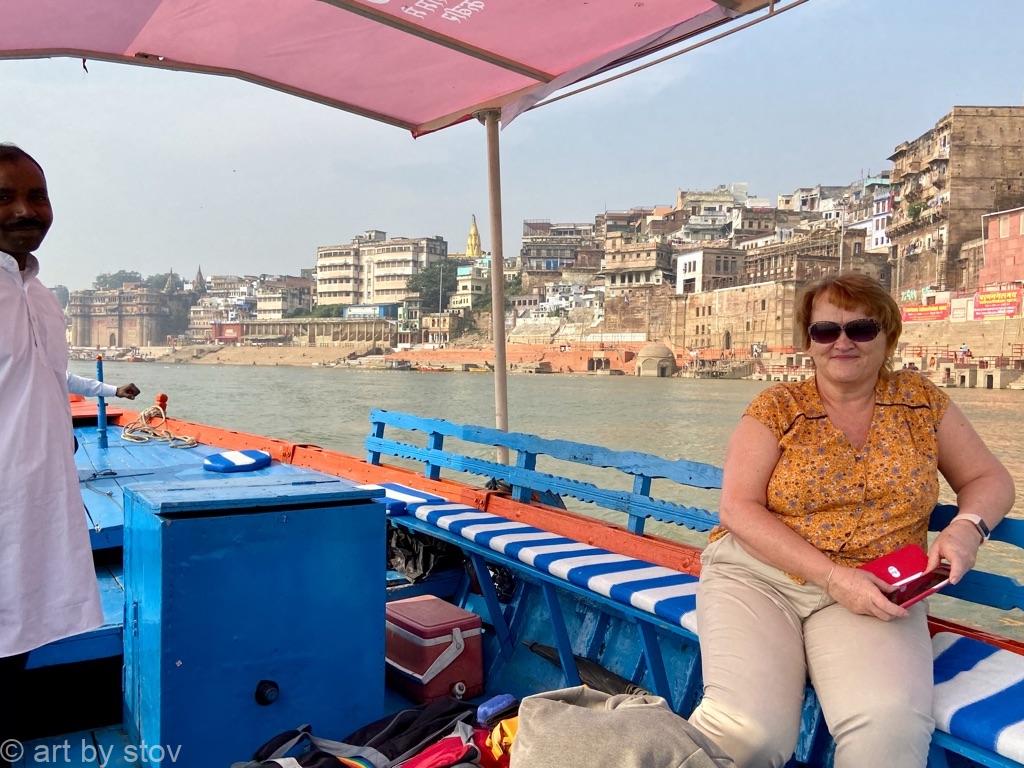
After our final nights sleep on the banks of the Ganges we rose at 08:00 to pack up our belongings. Our last boat ride at Varanasi was to be by Hotel taxi to the Rajghat, departing at 10am.
Our room phone rang at 09:30 “are you checked out to go, your man is waiting?” “No” we said “he is not due until 10:00, we have not had breakfast yet”. We had dawdled over packing and had only 15 mins to eat our morning feast. I had lovely hot sabzi (vegetable curry), shamber puri (flatbreads with a spicy lentil dipping sauce and samosas (small deep fried triangle of veggie loveliness) I washed it all down with fresh pineapple juice and a side of vanilla milkshake.
When we met Imran back at the landing ghat after 10:00 he said he told the hotel “if they have had breakfast and are ready so am I”. I noticed that the Spanish ladies had departed the landing heading towards the Rajghat at about 09:30 and surmised the hotel wanted us to join them to save having to send another boat. Tough, I was enjoying my last few minutes at the table with the best views up and down the river. Prime tourist time was past, there were now commercial boats delivering goods to the myriad of ghats for the hotels, restaurants and shops lining the bank; reminding me of back canal Venice.
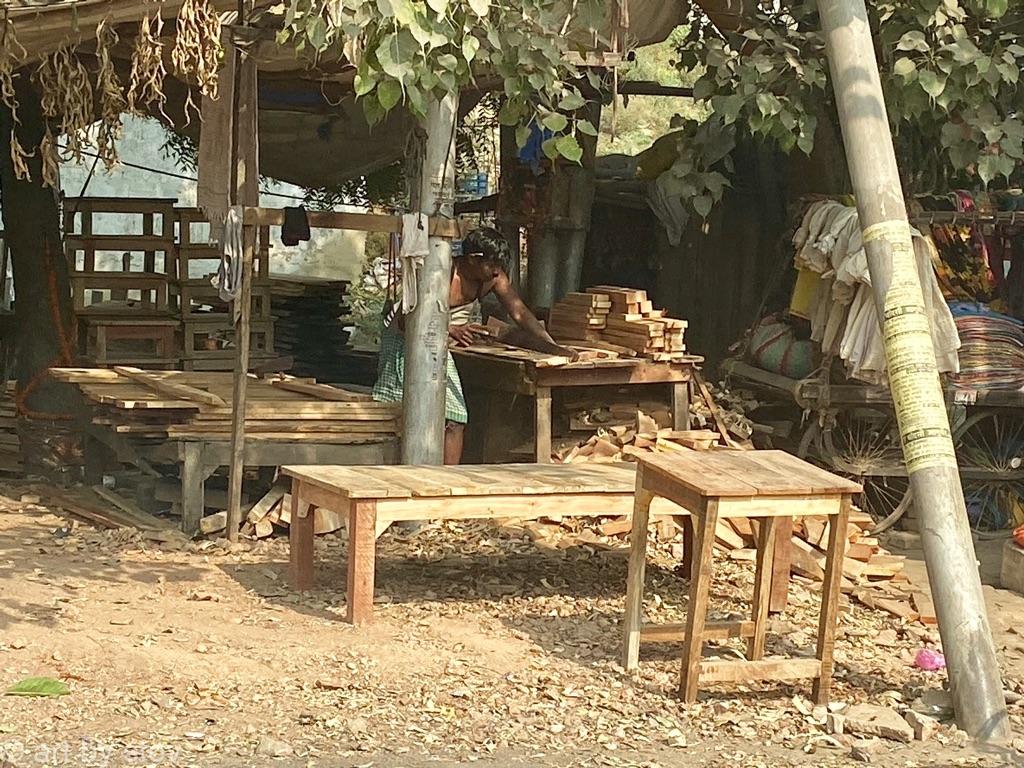
It was a very quick road trip from the ghat to the airport. At one point glancing out of the window I saw a carpenter plying his trade, working the wood deftly and surely with basic implements and benches. I love to see carpenters and cabinet makers at work, it reminds me of my paternal grandfather who was a master cabinet maker.
We had a new helper to see us through to security. Another filthy 10 IRS note handed over in thanks. Forewarned by our experience at Amritsar, I followed the unpack and repack routine effectively and efficiently to the satisfaction of the security team.
Our next flight from Varanasi to Khajuraho represented the last stage of the disaster recovery plan implemented by James at Sundowners. Our original carrier, Jet Airways, went bust in April. They were key to our itinerary covering the routes from Amritsar to Delhi, Delhi to Varanasi and Varanasi to Khajaraho. Air India quickly stepped in for the first two replacement legs but as of two weeks before our India trip we were facing a nine hour plus car drive to get us to our next destination and the loss of at least one safari drive.
Long car journeys, even with a fascinating view of rural India, make you tired. Just sitting there seems to sap the energy mentally and physically and that would have detracted even more from our enjoyment of the next leg of our journey.
Thankfully Vistara, another part of the vast TATA empire commenced flying the route at the beginning of November. James paid the extra £2 each to secure executive class – the ever lovely was thrilled at the thought of additional pampering and speedy boarding! Unfortunately the flight is only 50 minutes so no sooner had we taken off than we were landing. I can’t comment on the food and alcohol (there was none!) but the bottle of water and cup of tea in a china cup was lovely!
As we descended I saw out of the window part of the vast and stunning temple complex we were to visit.
We were met at the airport by Kishan and driven to the site of the Western Temples where we were introduced to our guide Anuraj (Anu). He was clearly well educated and also liked his birds. His mother was deputy chief of the National Education Department, held four degrees and Anu declared “she is still learning at the age of 79”. Anu was clearly a fanatic about world archaeology, throwing in references to Machu Picchu and Stonehenge , greater Zimbabwe, the Easter Island statues and many other world sites. We quickly realised that he knew more than we needed to know.
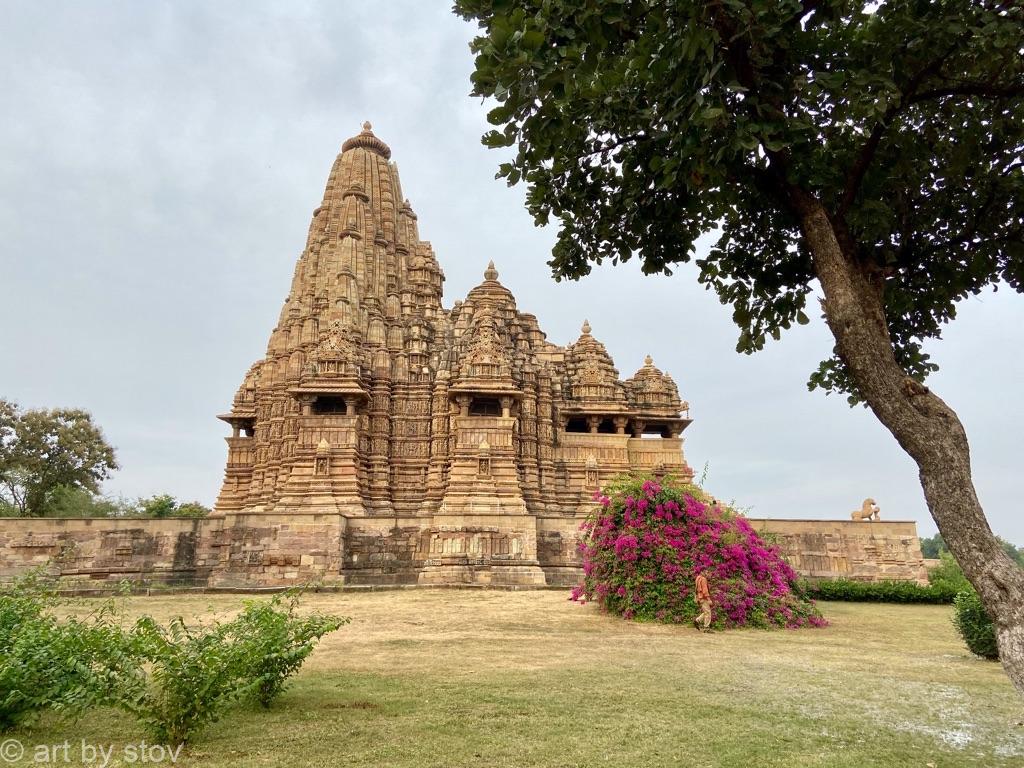
I spotted an Indian Roller in a tree (my first). Anu had the village ladies, who were plucking up weeds from the lawn under the tree, throw stones to get it to fly. It didn’t. I spotted a lesser racket tailed drongo flying instead which I was more than happy with. We caught up with the rollers when we went across to view the Eastern temples, along with more rose ringed parakeets, and a southern coucal.
The temples were incredible. The largest had 83 pinnacled towers representing all of the peaks of the Himalayas, where the Hindus believe Brahma lived. The carvings were most intricate covering the whole externally and internally. The temples were built on the cusp of the tenth and eleventh centuries AD. In the 12th century there were 85 temples over a 20 square kilometre site. Only 25 remain and they are a UNESCO World heritage site. Hidden in the jungle they were rediscovered by a British Surveyor in the 1830s. All bar one face the sunrise and have artwork highlighting the four goals of life for Hindus, namely:
Dharma – pertaining to living a virtuous, proper and moral life
Kama – pertaining to sensory enjoyment, emotional attraction and aesthetic pleasure
Artha – pertaining to Material prosperity, income security, means for living
Moksha – pertaining to liberation, release, self-actualisation
The temples are famous for their erotic sculptures, which i must say are pretty explicit but only amount to less than 5% of the total stonework of the temple complex.
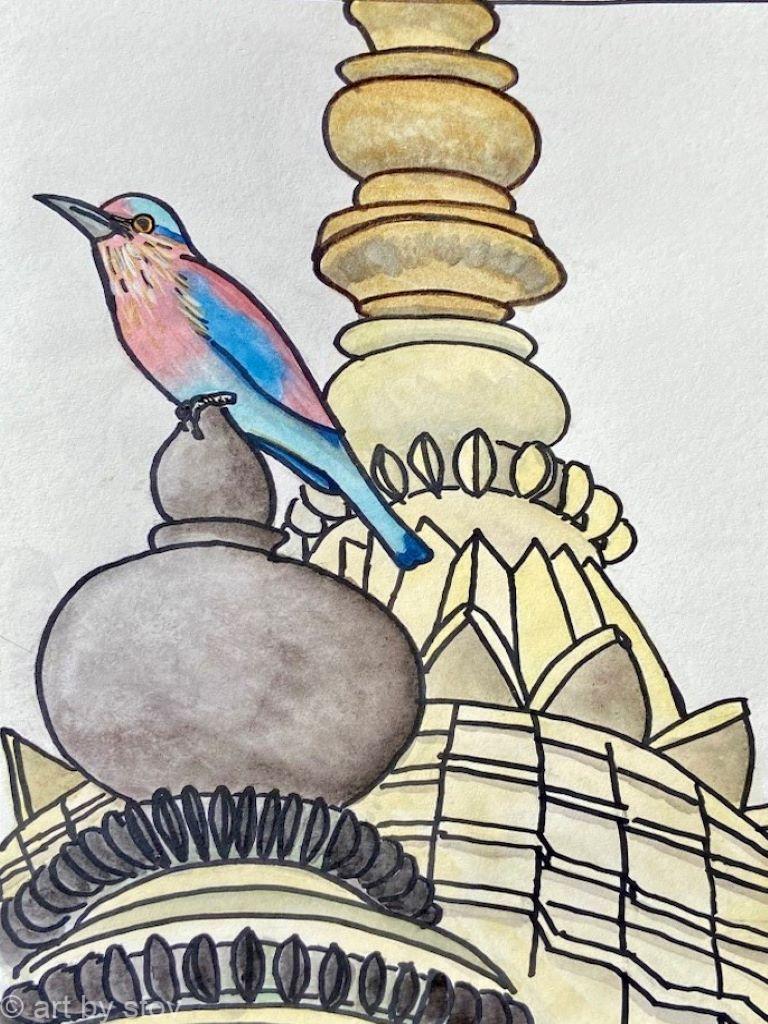
We wandered the Western site for a while before heading across to the smaller Eastern site. The temples here were less impressive and contained symbolism relating to the Jain religion. As we walked in a beautifully coloured Indian Roller perched on top of one of the temples (see sketch) and a Southern Coucal landed and hopped along the boundary wall.
Anu was into his bird spotting by now and asked if we wanted to see some Spotted Owlets. The whereabouts of these celebrities seemed to be known by everyone. The security guard guided us to the best view whilst another tour guide fired a green laser at the birds to highlight them. Thankfully the birds remained static and I achieved several lovely pictures both with and without the laser light show. It was now getting close to sun down and we glimpsed the silhouette of a bee eater as we left.
In the Western temple site I had expressed interest in the guide book and Anu said we could go to the village cooperative where they sell it for IRS 100 vs 350-400 on site. The cooperative is run by 365 local families making a variety of regional items for sale. The running of the shop is shared as are the costs and profits. I had set myself a target on the trip of purchasing a bronze Ganesha to go with my bronze Hanuman from Old Delhi, and felt this was my opportunity. They had an ideal candidate apart from the size. At 20 cm plus it was too large and would have dwarfed my pre-existent monkey god.
I hasten to add here that I have no ambition to collect statues of the full set of Hindu deities, there are thousands, some say millions of them. I have read that they are all in truth separate aspects of the one true god Brahma. Hanuman, the Monkey god has attributes of faith, courage and inner strength, keeping negative/evils things at bay. Ganesha, the elephant headed god, is regarded as a remover of obstacles and is often worshipped at the start of a trip or project to aid success. You often see Ganesha figures in taxis and other forms of transport a bit like the Christian St Christopher.
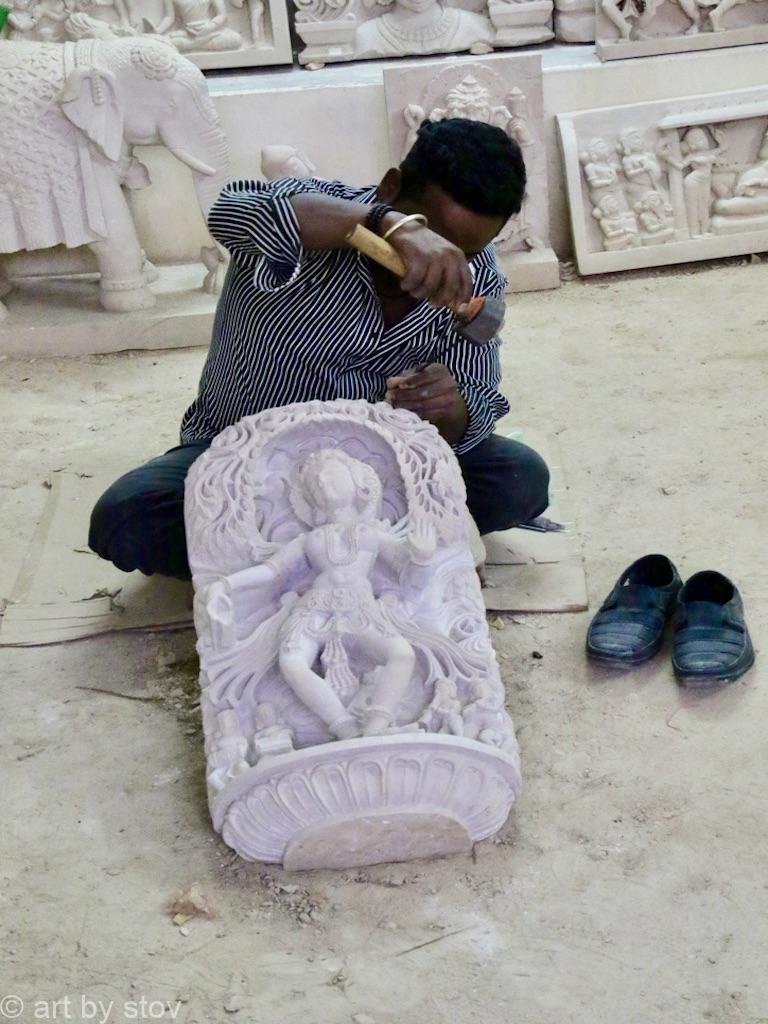
In the inner sanctum there was some very expensive looking jewellery. RTZ (Rio Tinto Zinc) own diamond and gold mines nearby, the biggest outside of South Africa. Not just white but also black, blue and green diamonds. The jewels were set in the 22 carat gold that Indians prefer. To the side of the main shop there was a masons workshop where they worked on pieces for local houses, tourists and when required replacement carvings for the temples (another photo opportunity for my men at work around the world series). Whilst we wandered the premises meeting and greeting various artisans we were plied with much needed and refreshing Massala Chai.
Despite the best attempts of the cooperative duty sales team to persuade us to part with our INR we left with only the guide book purchased.
I read, after our return to England, that the Khajuraho Temples are the second most visited site in India…. I find this hard to believe. It’s not an easy place to get to and certainly not over-developed for tourism, nor busy.
It turns out that Kishan is also a big bird watcher, he used to work in wildlife preservation locally and regionally. We spotted Cormorants on the lake as we left Khajuraho. I mentioned that I saw what looked like toucan flying overhead near the temples, though Kishan thought this highly unlikely and suggested they were Parakeets. On reflection these were probably Indian Grey Hornbill which are quite prevalent in Madhya Pradesh and certainly fitted the profile of the silhouette.
The sun was now properly down and we were definitely going to reach our base for the next three nights in the dark. The road drive was quick, the surface having been improved recently as part of a national drive to improve roads all across India. Sadly the improvements didn’t apply to the bridges which are now a combination of the old rough, potholed surface and a building site. This reminded me of a story told to me years back by the father of my son Andrew’s rugby team mates. Back in the early years after the fall of communism in eastern europe he used to drive lorries across Europe to deliver clothes and blankets for the poor and displaced in Romania. Apparently, the motorways were three lane perfection, hard shoulder, central reservation and white lines but when you came to a bridge it suddenly went down to a single lane with no warning. Under each bridge were the numerous remains of vehicles, the drivers of which had not adapted to change quickly enough.
As we reached our destination on the banks of the Riven Kenn, the Sarai at Toria, we felt relieved that we had been able to fly and do the temples on the day we left Varanasi. Had we driven we would just about be arriving now and have had to cram the temple trip into the next day which in itself was pretty full on as you will read next week.
So why did we come to the Sarai at Toria, way out in rural Madhya Pradesh. Partly on the recommendation of our brilliant travel company – Sundowners, but largely because of the beauty of the river Kenn and the nearby Panna Tiger Reserve, both of which teemed with wildlife and in particular birds. How little did we realise what a treat was in store for us.
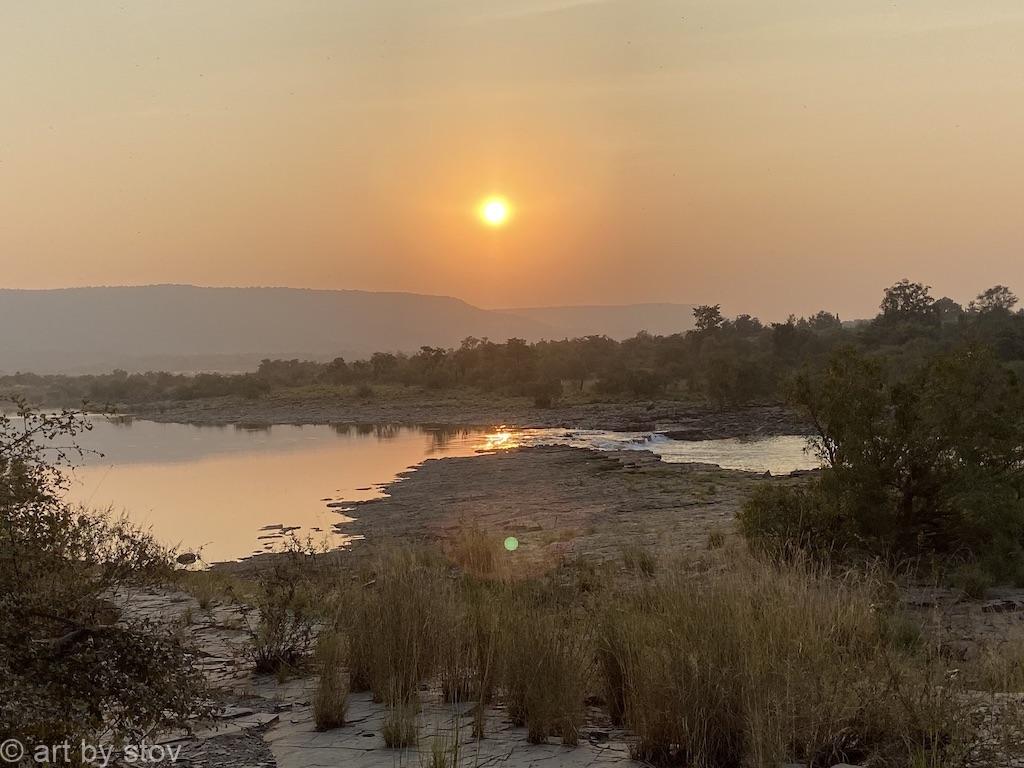
We pulled off the main road onto a dirt track along the side of fields. The car park at the end was very rustic, reminiscent of the brickwork yards we saw on the road in Rajasthan in 2015; workman-like with a sense of beauty and tradition. Piyush the manager met us and we walked with him across an arched bridge, three foot wide, over a forty foot deep gulley.
We kept walking up the far bank and into trees before being met by tall grass on either side of the path. At the top of the path, glimpsed at first through the waving stems, was the Sarai. Traditionally built with open sides and mud floor and looking every inch authentic Indian rustic.
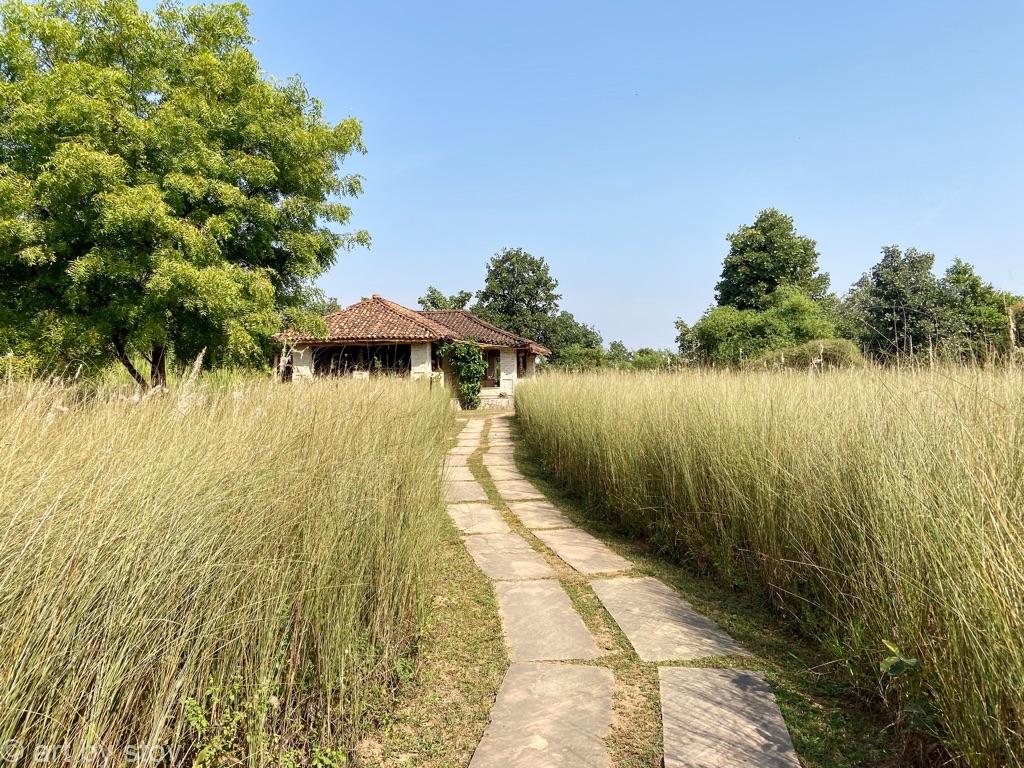
We were given a lovely, refreshing welcome drink after warmed hand flannels. Joanna, our hostess, met us and introduced us to Raghu, her husband; they are the owners. We knew from the Sundowners website that he was a wildlife preservation biologist and she a wildlife photographer, we were to learn more as we got to know them over the next two days – we were the only two guests at that point.
We immediately felt at home, and after a delicious pot of masala chai and home made biscuits we were escorted through the shoulder high grass by a torch bearing man along a different path to our room. We were greeted by a log fire outside on the patio. More on our lovely room later on; we didn’t even have time to shower before heading back to the patio for pre dinner drinks.
Raghu and Joanna had guests for dinner. One, a lovely gentleman, is recently retired and from Indore in the far west of Madhya Pradesh. He told us Raghu was born there. Apparently Indore is reputed to be the cleanest city in India. We chatted, sipped pre dinner drinks and enjoyed home cooked appetizers with them all.
Blankets were offered and drinks proffered (the ever chose lovely gin and tonic and I an ice cool beer as we chatted with Joanna and father in law.
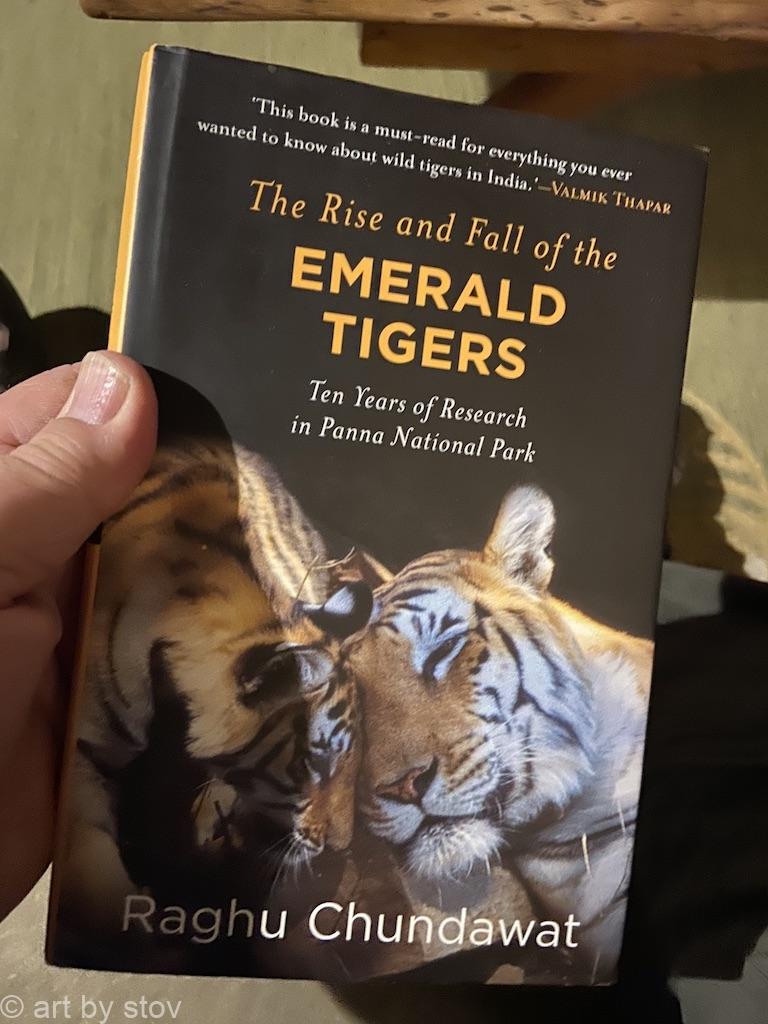
Commenting on how wonderful the Sarai was, Joanna shared a bit of history. After studying snow leopards in the Himalayas, Raghu conducted the longest extant study of tigers in the wild, here at Panna from 1996 to 2006. Unfortunately it all came to an end when there was a change in the park management and tigers began to disappear. Raghu’s concerns fell on deaf ears so he raised them with the wildlife authorities who failed to act. He then raised it at Government level and again was ignored. In the end he went to the press and it all broke. Gordon Buchanan, one of our favorite wildlife film cameramen, filmed a programme for the BBC: Tigers of the Emerald Forest. Raghu also wrote a book with the same title which I flicked through with great interest (and later purchased in Delhi).
Pre-dinner snacks were tasty home made samosas and hot tomato chutney. The smells coming from the kitchen were tantalizing and we moved to the cosy dining area. We were attentively, yet unobtrusively served as we dined. Joanna, Raghu and guests were eating later.
We are told Raghu enjoys cooking, even though they now have several chefs, one was previously one of Raghu’s research students and the other a pastry chef from a high end hotel in Bihar state. Dinner was rice, chapattis (so soft), bindi, green peppers, dhal and chicken in coconut sauce. Dessert was a chocolate fondant followed by coffee. All of the super-fresh ingredients were sourced locally or grown in their vegetable garden. Both Raghua and Joanna each checked in on us whilst we ate. Apparently Raghu devises the dishes from old family recipes.
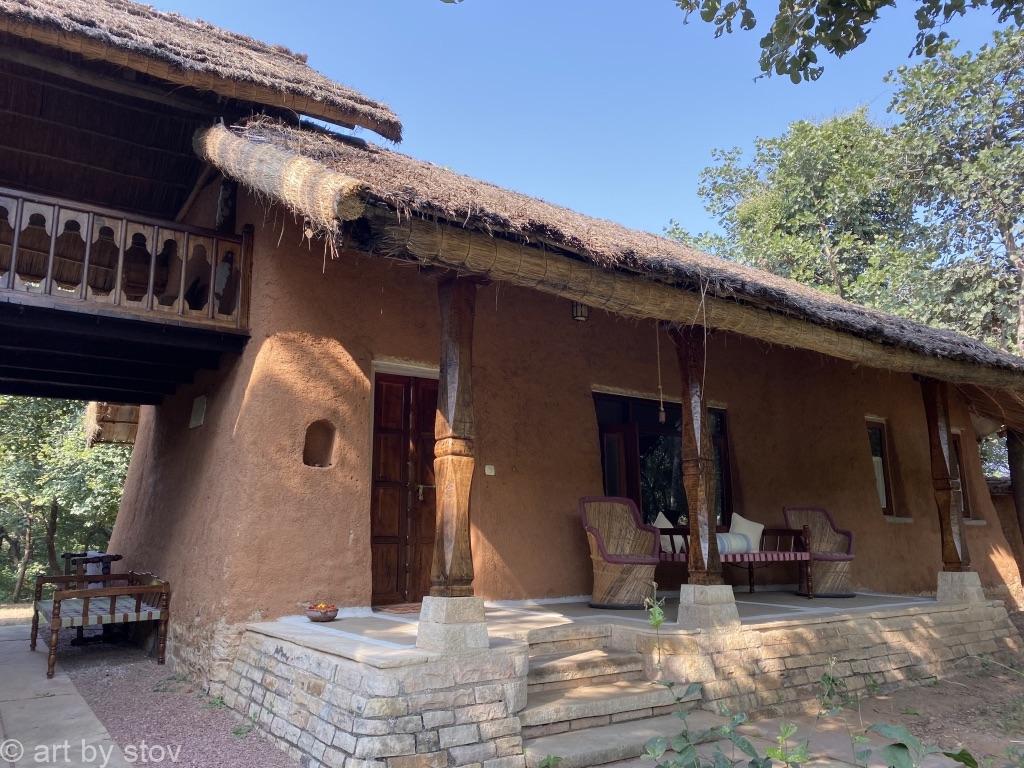
Replete, we took a torch lit stroll back to our room. The various buildings at the Sarai are all built using traditional methods. The skills for this are fast disappearing and they had to use workers from Kerala 2000 kilometres away to create the guest cottages in village style. The walls and floors are made of mud to aid longevity. A 15ft high vaulted, beamed ceiling ensured the room kept cool. Internal stairs led to a 3rd bed and from here a door out onto a viewing platform shared with the room next door. Not that shared meant anything to us.
Their guests leave tonight, we are the only guests tomorrow and then there is a small group on our last day. Since Jet Airways collapsed back in April the tourists have dried up. They hope that Vistara makes a go of their new air service as tourism is the main income source in the area.
Join me next week in Tiger Country encountering stripey and spotty cats and taking breakfast in the bush
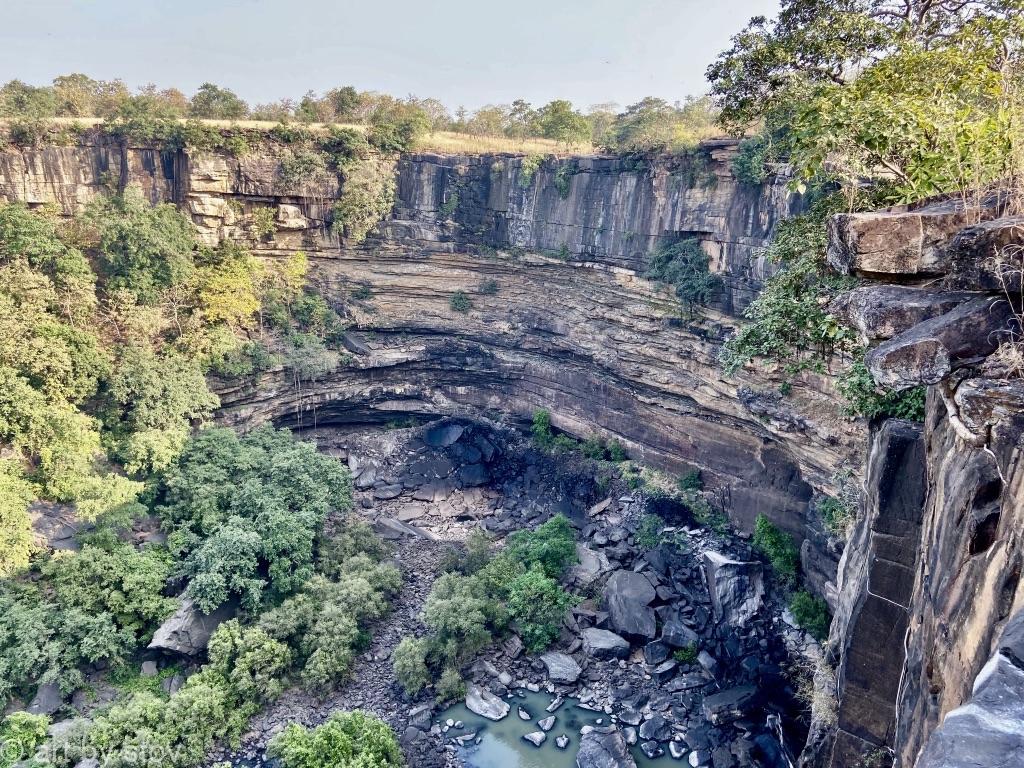
Missed an earlier Blog? Read about it here